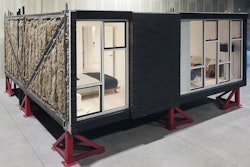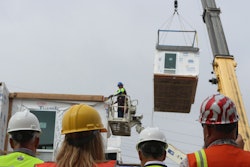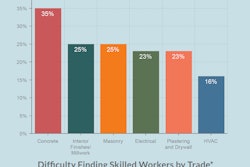
Factories in flat-packs and homes built in factories — modular construction will build new momentum in 2018. However, the industry is battling with significant skills shortages and must manage increasing globalization.
Skills shortages will force the industry to adapt to new technology and business models
A shortage of one crucial resource threatens the rate of growth worldwide. On every continent, skills and labor shortages are hitting hard. In 2018, it could force permanent, decisive changes in how construction does business and meets demands.
The recent global Turner & Townsend international construction survey shows that 23 of the 43 markets surveyed suffers from skills shortage, up from 20 the previous year. Only four regions reported a surplus; Muscat, Perth, Santiago and São Paulo, according to the survey. Another source pointing in this direction is the World Economic Forum Report, ‘Shaping the Future of Construction’, that shows that the US construction industry’s productivity has fallen 19% since 1964.
In the same period, non-agricultural industries improved by 153%. This was also brought up in the UK in a recent government-commissioned report, the Farmer Review, that has rung alarm bells in the construction industry. Subtitled Modernize or die, time to decide on the industry’s future, it details how skills shortages drive costs up, quality down, and lead to poor productivity.
However, there is hope too. The review details many innovative high-quality cases where the merger of manufacturing and construction has opened up new markets and revenue streams with creative construction solutions.
One such modular construction is GSK’s ‘factory in a box’, designed by modular and BIM construction studio Bryden Wood. The solution is a color-coded, easy-to-assemble pharma factory that can be shipped in a crate and put together in emerging markets — helping meet demanding local compliance standards, high potential, but limited money available for large specialist onsite teams. Designed with business information modeling (BIM), the factory in a box is a great example of how design-led innovation in construction can produce more assets with fewer resources.
In 2018, I believe we will see a perfect storm of factors — an aging global workforce, a lack of new entrants and growing restrictions on free movement of labor — begin to decisively accelerate the uptake of construction-integrated manufacturing. Governments, regulatory bodies and the industry alike will start to realize that, while getting more people into the industry is important, as well as trying to increase the number of people onsite, the most strategic solution would be to fundamentally change the way we build in the first place.
Skills shortages are worldwide
In the U.S., the Associated General Contractors of America found that 86% of 1,400 firms had difficulty filling available posts, with carpenters and concrete workers topping the list.
In the UK, 400,000 skilled workers will retire from the construction industry in the next 10 years (CITB, Construction Industry Training Board.) Over the next five years, 182,000 new jobs will need to be filled.
In Asia too, labor shortages loom. Over the next 30 years China’s working-age population will shrink by 180 million. The ILO (International Labour Organization) forecasts that China’s projected labor shortfall in 2030 will be equivalent to 24% of its current working-age population.
With construction-integrated manufacturing, 10% of traditional contractors could disappear over the next five years
It is beyond doubt that modular construction and construction-integrated manufacturing is playing an increasingly important role all over the world.
Modular is expected to rise 6% globally by 2022, with some countries already leading the pre-fab charge. Sweden is a model for modular home building — around 84% of detached homes built in the Scandinavian nation use pre-fabricated timber elements. Compare this against the U.S., Australia and the UK where the figure is just 5%, and Sweden is practically a modular world leader. Meanwhile, also the third-world countries are considering how pre-fab can meet their housing shortages and cost constraints. Nigeria is one example that is taking a long look at modular housing to meet its crippling housing shortage — close to 20 million units at the last count.
In Japan, around a quarter of all new houses are prefabricated. Japan’s success shows both the quality of assets manufactured in controlled conditions and how many new entrants they attract. As well as market leaders Sekisui House and Daiwa House, Japanese retail giant Muji recently started developing modules, and Toyota has manufactured prefabs for over 20 years. Japan particularly prizes prefab construction for its quality and efficiency. Offsite modular construction removes the last-minute changes that can plague onsite construction and reduce the quality of the finished asset. Small wonder from 1963 to 2014 manufacturers built 9 million prefab homes in Japan.
With growing skills shortages and a need to build faster and more cost-effectively, it will become a crucial competitive advantage to be able to invest in the right technologies and people and find the right business partners to leverage construction-integrated manufacturing.
Globalization will increase foreign content of construction projects by 20% within 5 years
Offsite, logistics-centric construction will be a catalyst for increased globalization, too. Currently, 95% of construction projects are carried out by local firms sourcing local materials. But we see that this is changing. Customized, large-scale components and elements will increasingly be sourced globally, meaning increased competition and, potentially, margins. It’s a big shift for an industry that has traditionally been highly country-specific. But for operators agile and disciplined enough to start planning and handling logistics and invest in new joint ventures, the gains could be huge.
Take Spain. With a significantly smaller GDP than, for example, the U.S. or the UK, seven of the world’s top 100 construction companies are Spanish. Yet while the country’s recent economic difficulties took out many companies, Spain’s construction sector fared remarkably well. One of the main reasons is that Spanish construction companies often partner globally and thereby reduce the risks of exposing the business to domestic economic challenges. Here, the Spanish construction industry’s strong tradition of joint ventures and global partnerships was a powerful competitive advantage.
New technology is making it easier to work profitably on a global level as well. With 3D printing, for example, costs for both material and long transports are decreasing substantially. Using technologies such as these, the partnerships will focus more on global competence exchange rather than long-haul transports.
All three of these trends are woven tight together. Contractors need to work hard to ensure that the right competences are secured while considering how to implement new business models for modular buildings and construction-integrated manufacturing — all this in a construction industry that is becoming more global and offers new forms of partnerships. The players who master this balance act will be the winners in 2018.
Kenny Ingram is the Global Industry Director at IFS for the following industries: Construction, Contracting, Engineering, Infrastructure and Shipbuilding. In addition he is heavily involved in other Project and Asset Lifecycle industries including Oil and Gas, Energy, Utilities and Defence. Kenny's main responsibilities are to promote the IFS solution to the external marketplace and to educate the IFS workforce on the business issues and challenges these industries face. Kenny has been with IFS for 16 years and has worked in the business systems marketplace for over 20 years. IFS develops and delivers enterprise software for customers around the world who manufacture and distribute goods, maintain assets, and manage service-focused operations.



















